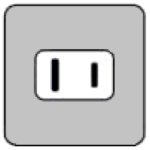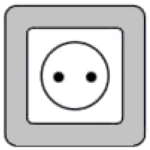Plug For North Korea: What You Need To Know
What is the plug for North Korea? Before you travel, check the information below to make sure your electronic devices are compatible with the outlet type and voltage.
Electrical Summary
North Korea uses outlet types A, C at a voltage of 220V and a frequency of 50 Hz.
Plug Compatibility: Type A, Type C
Voltage: 220V
Frequency: 50 Hz
Type A

Type C

Can North Americans use Electronics in North Korea without an Adapter?
No! North Americans may need an adapter for the outlets when traveling to North Korea. North Americans device plugs may not work with all outlet types in North Korea. Also, a transformer is required as the voltage in North Korea may be different from Europe.
Please note: an adapter will be needed if your device plug has a grounding pin and you are trying to use a Type A outlet. For this reason, we always recommend traveling with a universal travel adapter.
Can Europeans use Electronics in North Korea without an adapter?
No! Europeans may need an adapter for the outlets and a transformer for the voltage when traveling to North Korea. European device plugs may not work with all outlet types in North Korea. However, the voltage in North Korea is the same as European voltages.
What Outlet does North Korea Use?
Type A

Type C

Type A electrical plug sockets have two flat pins and no grounding pin. These outlets are typically used with devices that have a voltage of 110-120V. This outlet is rated for 15 amps. Plug Type A is compatible with this socket. All other plug types (including Type B) will need an adapter.
Type C plug sockets are used in Europe, Africa and Asia. They have two round pins and no grounding pin. These plugs are typically used with devices that have a voltage of 220-240V.
Is it safe to drink water in North Korea?
To be on the safe side, you can use common precautions such as boiling tap water for at least one minute, using water purification tablets, or drinking bottled water. It’s also important to note that ice may be made from tap water and that foods may be washed or prepared with tap water.
We recommend always packing a filtered water bottle when traveling:
Travel Essentials
Be sure to check our list of travel essentials before your trip!
Should I get travel insurance when traveling to North Korea?
It is generally recommended to get travel insurance when traveling to a different country. Travel insurance can provide financial protection and peace of mind in case of unexpected events, such as medical emergencies, trip cancellations, lost or stolen baggage, or other travel-related mishaps.
Travel insurance can cover various expenses related to your trip, such as medical expenses, emergency medical transportation, trip cancellation or interruption, lost or stolen baggage or personal belongings, and other travel-related expenses.
Before purchasing travel insurance, it’s important to carefully review the policy details, including the coverage limits, exclusions, and any applicable deductibles or copays. You should also make sure that the policy covers any activities or destinations that you plan to participate in or visit during your trip.
Travel Summary
Travelers are required to book their trip through authorized tour operators and must be accompanied by a government-appointed guide at all times. Visitors are restricted in their movements and activities, and access to the internet is severely limited.
Despite the challenges, there are some unique experiences that travelers can have in North Korea. Visitors can learn about the country’s history and ideology through visits to museums and monuments, such as the Korean War Museum and the Kumsusan Palace of the Sun, which is the mausoleum of the country’s leaders.
North Korea is also home to stunning natural landscapes, including the Mount Kumgang and the Paektu Mountain, which are popular destinations for hiking and trekking.
In conclusion, traveling to North Korea can be a unique and challenging experience. However, travelers should be aware of the risks and challenges involved and should take necessary precautions to ensure their safety and well-being.
Traveling to another country? Check out our Countries page for more info.